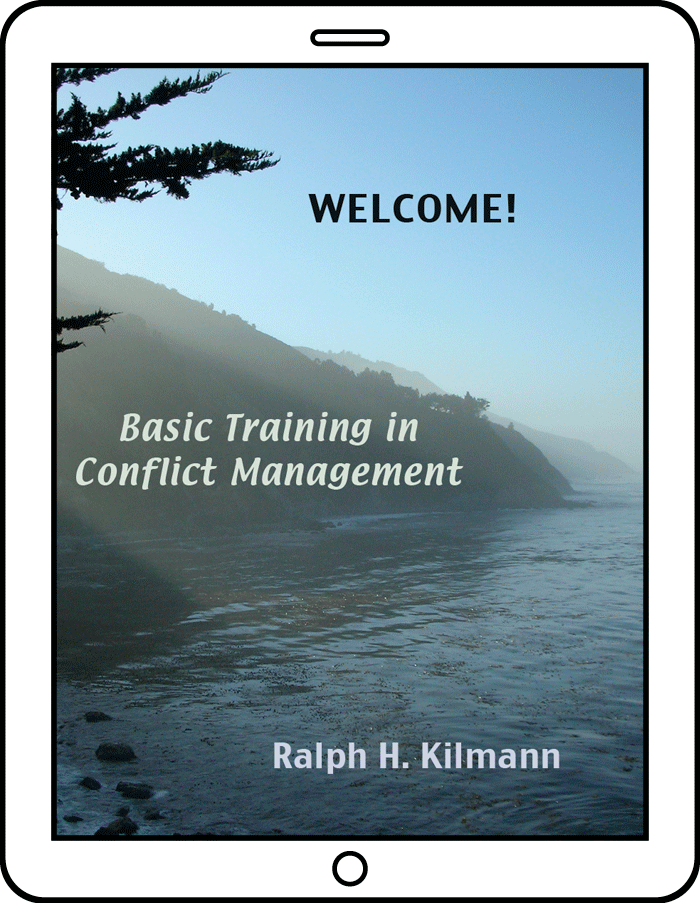
How to combine this online course with live discussions
The members of the same work group (whether a department, task force, project group, cross-functional team, or process improvement team) will gain extra benefits from taking any of our online courses AS A GROUP. Rather than members of an organization taking our online courses separately and thus independently, learning key principles and practices with your workplace colleagues will not only enhance what every member learns from our online courses, but will also make it much easier to apply what is learned back on the job—where it counts.
Basically, when all group members (1) learn the same language and the same concepts, (2) review the same assessment tools and their personalized results, (3) analyze and discuss the same business cases, and (4) follow the same guidelines for effective behavior—BECAUSE all these principles are fully shared in the group, they are more likely to be put into practice when challenging problems and conflicts appear in the workplace.
On this page, I outline how a work group can take full advantage of all the valuable materials in BASIC Training in Conflict Management. The unnumbered paragraphs describe what members are asked to do on their own, such as watch the course videos, take assessment tools, or complete work sheets in their course manual. Meanwhile, the numbered paragraphs provide the detailed steps for learning the material through face-to-face or virtual group meetings. Depending on the unique circumstances and needs of each group, this process for blended learning can be adjusted or expanded.
THE DETAILED STEPS
Before beginning the BASIC course, each member should first complete the Thomas-Kilmann Conflict Mode Instrument (TKI) with these modified instructions:
INSIDE your group, how do you usually respond when you find your wishes differing from those of another group member?
When members are about to take the TKI assessment, instruct them to IGNORE the standard TKI instructions that appear on their computer screen or Internet tablet. Instead, they should keep in mind the modified TKI instructions (and the members of their group) as they respond to all 30 A/B items on the assessment.
After all group members have individually reviewed their personalized TKI Report and, on their own, have also watched the entire eighty-minute course while making good use of the Course Manual for Basic Training in Conflict Management, I recommend they discuss the following topics in a sixty-minute meeting:
1. As a group, members spend a little time making sure everyone understands the TKI Conflict Model, especially the dimensions of assertiveness and cooperativeness, and the integrative, distributive, and protective dimensions of conflict behavior. Then members share examples of using each of the five conflict modes effectively and suggest whose needs get satisfied in the process. Next, members review the eight key attributes of a conflict situation that determine when each mode is most likely to achieve the most satisfaction for all key stakeholders (internal and external to the organization). Then members discuss the best approach to conflict, given all the principles and practices discussed in BASIC Training in Conflict Management.
2. Based on each person’s TKI report, make a tally of how many members scored highest or tied for highest (in the high 25%) on each of the five conflict-handling modes. Also make a tally of how many members scored lowest or tied for lowest (in the low 25%) on each of the five modes. Then plot these results on the TKI Conflict Model on pages 16 and 17 in the manual. Then group members should discuss: Are the identified HIGH or LOW modes actually being used too much or too little? Or are those HIGH and LOW modes actually being used effectively, since these conflict-handling behaviors fit the key attributes of the group’s situation?
3. Discuss why approaching workplace problems with a different set of conflict modes (having ALL five modes available to every group member) would likely result in different experiences and outcomes for the group. And how would the organization and its external stakeholders benefit if group members used different modes for their recurring workplace conflicts?
4. Develop an action plan to encourage more discernment in using conflict modes more consciously—and purposefully—in the workplace, so as to maximize personal satisfaction and value-added contribution to the work group and the organization. TAKE NOTE: Which variety of conflict modes did members use to develop this action plan—and what were the consequences of using these modes on group performance and member satisfaction?
5. How will the work group implement its action plan and then monitor the results for the purpose of ensuring that workplace conflicts are being managed effectively and efficiently? In a subsequent course, ADVANCED Training in Conflict Management, group members will recognize these processes as the steps—and errors—of problem management.
On their own, group members can test their knowledge of the key principles of this course by taking the optional Final Exam for BASIC Training in Conflict Management. Although Kilmann Diagnostics does not award a “certificate of achievement” for this course, receiving a score of 88 or more points (out of 100 possible points on twenty-five, multiple-choice questions) signifies that members have passed the exam and have thus learned the material.
NOTE: The optional Final Exam for every course can be taken as many as five times, since its purpose is to encourage members to learn the material—not to add stress to their life. However, if someone else purchased these courses for the group, the sponsor (for example, the employer) might require group members to pass each exam as an indication that they’ve learned the material. But Kilmann Diagnostics will not share any exam results if a member happens to score less than 88 points on any occasion for any course. We’ll only inform the sponsor when members pass their exams. Click to see Sample Questions on Each Final Exam.




